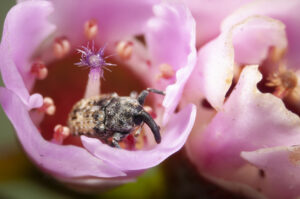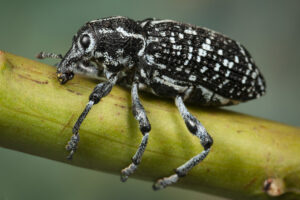
Weevils are not all pests
By Denis Crawford
Think weevil, think pest? Think again. Weevils are incredibly diverse, and some species are plant pollinators.
With about 400,000 species worldwide, the insect order Coleoptera (beetles) accounts for about 25% of all animal species on earth. 20% of those beetles are weevils of the superfamily Curculionoidea. Yep, weevils are beetles and there are about 62,000 species of weevils described to science so far.
Taxonomists say that number – 62,000 – is way short of the estimated total number of weevil species – 220,000. That means that only about a quarter of the diversity of weevils has been described. At current rates of discovery and description, it will take another 650 years to describe the rest! (Oberprieler et al. 2007). There are more than 6,000 Australian species of weevils described – so far.
Weevils can be distinguished from most other beetles by their elbowed antennae, and the way their heads extend forward into a snout (rostrum) at the end of which are their mouthparts. Like all beetles, weevils have a lifecycle of complete metamorphosis – egg, larva, pupa, and adult. Weevil larvae are often called ‘grubs’.

There are a few pest species to be aware of, including:
- Argentine stem weevil (Listronotus bonariensis) and Billbug (Sphenophorus brunnipennis) – turf pests.
- Black vine weevil (Otiorhynchus sulcatus) – pest of various ornamental plants and grapevines.
- Fuller’s rose weevil (Naupactus cervinus), garden weevil (Phlyctinus callosus) and whitefringed weevil (Naupactus leucoloma) – pests of fruit trees, vegetables, and various ornamental plants.
- Polyphagous shot hole borer (Euwallacea fornicatus) – a new tree pest in Perth, Western Australia. (Detailed in March Hort Journal)
- Vegetable weevil (Listroderes difficilis) – a pest of various vegetables and ornamental plants.
What these pest species have in common is they are all introduced from somewhere else – none are native insects. Further information on most of these weevils can be found in Pest Files of December 2012. There are other pest species of weevil in broadacre agriculture (e.g., small lucerne weevil Atrichonotus taeniatulus and sitona weevil Sitona discoideus), and stored food products (e.g., grain weevils Sitophilus spp.). They are also introduced pests. Fortunately, weevil pest species collectively make up a tiny proportion of weevil diversity.
This quote highlights the ubiquity and diversity of weevils: “Probably no flowering plant escapes their notice, and many species of higher plants have many weevil species obligately attached to them. Many higher plants depend upon weevils for pollination. All parts of plants are eaten by weevils from roots, bark, sapwood, heartwood, stems, twigs, buds, flowers, pollen, fruits, seeds and sick, dying, dead and decaying plant material.” (Zimmerman 1994)
I was curious to find out how widespread weevil pollination is. A recent paper (Haran et al. 2023) looked at more than 600 species of weevils, including those that spend their entire life cycles on or within the specific plant that they help pollinate. In other words, the paper concentrated on weevils that use the plants they pollinate as breeding sites for their larvae.

The most well-known of these interactions is between a small African weevil Elaeidobius kamerunicus and the oil palm Elaeis guineensis. As one of the paper’s authors said, “Oil palm was not a viable industry until someone figured out that the weevils found with them were their pollinators”. The weevil was introduced from Africa into the oil palm growing regions of Sabah, Indonesia in 1981.
Adult oil palm weevils lay their eggs in male inflorescences of the palms, and the larvae that hatch from the eggs feed on, and eventually pupate on, the male inflorescences. Pollination takes place when adult weevils fly from male to female inflorescences to feed on the pollen. The introduction of the African weevil was paramount in the expansion of the Indonesian oil palm industry. It was not a great outcome for the environment though – rainforest destruction, collapse of the orangutan population, etc., but humans were responsible for that, not the weevil.
Oil palms are not the only palms with specific weevil pollinators. The same paper (Haran et al. 2023) shows that at least 87 palm species (Arecaceae) rely on about 200 species of weevils for pollination. The authors of the study said, “We are highlighting a group of insects that most people want to see killed, and we’re showing that they can actually be pretty important for maintaining ecosystems. We hope we can help other researchers and the public to better appreciate the role of weevils as pollinators, especially in the tropics.”
Growers of cycads probably already know this, but there are at least 91 cycad species from all three cycad families (Cycadaceae, Stangeriaceae, and Zamiaceae) that rely on weevils for pollination. Other studies have shown that weevils are also pollinators of multiple species of Anthurium (Araceae) in their natural range in Costa Rica.
As we saw earlier, most species of weevils feed on plants in some way or other, but only a few species are serious pests. Most weevils only cause minor damage, and some species are beneficial in that they help pollinate the plant they are feeding on. Several weevil species have been introduced into Australia to control a few invasive weeds such as salvinia, mimosa, and parthenium. So, weevils are not all bad.
References:
Haran et al. (2023). Most diverse, most neglected: weevils (Coleoptera: Curculionoidea) are ubiquitous specialised brood-site pollinators of tropical flora. Peer Community Journal, 3.
Oberprieler et al. (2007). Weevils, weevils, weevils everywhere. Zootaxa, 1668 .
Zimmerman, E.C. (1994) Australian Weevils (Coleoptera: Curculionoidea). Volume I. CSIRO, Australia.
Main photo: This tiny weevil is helping pollinate these Thryptomene flowers (image supplied by Denis Crawford)
